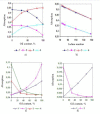Study of vegetable oils and their blends using infrared reflectance spectroscopy and refractometry
- PMID: 36974180
- PMCID: PMC10039264
- DOI: 10.1016/j.fochx.2022.100386
Study of vegetable oils and their blends using infrared reflectance spectroscopy and refractometry
Abstract
The present study aims to perform a comparative analysis of vegetable oils and their two-component blends using infrared spectroscopy and refractometry. The study was conducted in Almaty (Kazakhstan) in 2020. Three samples of 44 vegetable oils and their blends made from two components were examined. Fractometry and infrared spectroscopy were used to investigate the properties of blended vegetable oils. To this end, the fatty acid fraction (in percentage), iodine number, and index of refraction (IOR) were calculated. Afterward, the spectrograms obtained for the blends were analyzed. It was found that the difference between the intensities of weak bands and the band expansion of 722 cm-1 indicates greater expressiveness. When low-intensity bands (1653 cm-1) become more distinct due to vibrations of double carbon bonds (C-bonds), the level of unsaturated fatty acids in the blend increases as well.
Keywords: Blends; Infrared spectroscopy; Refractometry; Spectrograms; Vegetable oils.
© 2022 The Authors.
Conflict of interest statement
The authors declare that they have no known competing financial interests or personal relationships that could have appeared to influence the work reported in this paper.
Figures










References
-
- Altunay N., Gürkan R. A new simple UV-Vis spectrophotometric method for determination of sulfite species in vegetables and dried fruits using a preconcentration process. Analytical Methods. 2016;8(2):342–352.
-
- Bai S., Li S., Yao T., Hu Y., Bao F., Zhang J.…He Y. Rapid detection of eight vegetable oils on optical thin-film biosensor chips. Food Control. 2011;22(10):1624–1628. doi: 10.1016/j.foodcont.2011.03.019. - DOI
-
- Celenk V.U., Gumus Z.P., Argon Z.U., Buyukhelvacigil M., Karasulu E. Analysis of chemical compositions of 15 different cold-pressed oils produced in Turkey: A case study of tocopherol and fatty acid analysis. Journal of the Turkish Chemical Society Section A: Chemistry. 2018;5(1):1–18. doi: 10.18596/jotcsa.335012. - DOI
LinkOut - more resources
Full Text Sources

